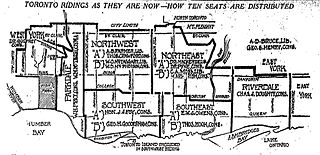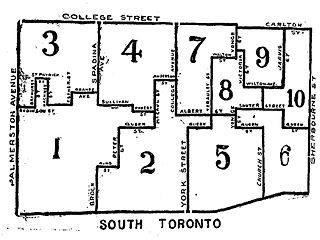
St. Andrew was a provincial electoral district in Ontario, Canada, that was established to elect Members of the Legislative Assembly (MLAs) and then Members of Provincial Parliament (MPPs) to the Legislative Assembly of Ontario.

Bellwoods was a provincial riding in Ontario, Canada in the old City of Toronto's west-end. It was represented in the Legislative Assembly of Ontario from 1926 until 1987, when it was abolished and redistributed into the Dovercourt, and Fort York districts.
St. Andrew—St. Patrick was a provincial electoral district in Ontario, Canada, that returned Members of Provincial Parliament (MPPs) to the Legislative Assembly of Ontario at Queen's Park.

Riverdale was a provincial riding in Ontario, Canada that existed from 1914 to 1999. It occupied an area east of the Don River from the city limits just north of Danforth Avenue south to Lake Ontario. It was named after the neighbourhood of Riverdale. In 1999 a major reduction in Ontario seats resulted in Riverdale being merged with part of East York into a larger riding called Broadview-Greenwood.

Dovercourt was the name of a provincial riding in Ontario, Canada. It existed from the 1926 election to the 1999 election. When it was established, it bordered Brockton on to the west, York South to the north, and Bracondale on the east. Lake Ontario was its southern border for most of its existence. At its abolition in 1999, it consisted of that part of the city of Toronto bounded on the north by the former city limits, on the east by Bathurst Street, on the south by Bloor Street and on the west by the CN Railway and St. Clair Avenue. It was redistributed into Davenport, St. Paul's and Trinity—Spadina ridings.

Eglinton was a provincial electoral district located in Toronto, Ontario. From 1926 until 1999 it elected members to the Legislative Assembly of Ontario. At its abolishment in 1999 it consisted of the neighbourhoods of Davisville and Lawrence Park in the north end of the old city of Toronto. It was abolished into Eglinton—Lawrence, Don Valley West and St. Paul's.

Davenport is a provincial riding in Toronto, Ontario, Canada. It elects one member to the Legislative Assembly of Ontario.
Fort York was a provincial electoral district in Toronto, Ontario, Canada. It was created in 1987 and was subsequently abolished in 1999 when the ridings were redistributed to match their federal counterparts. The riding had only two representatives:

St. Patrick was a provincial electoral district in Ontario, Canada, that was established in 1926 out of the district of Toronto Northeast. It lasted until 1967 when it was merged with St. Andrew to form St. Andrew—St. Patrick.

Trinity—Spadina was a provincial electoral district in Ontario, Canada, that was represented in the Legislative Assembly of Ontario since 1999.

Bracondale was a provincial electoral district in Toronto, Ontario, Canada. It was represented in the Legislative Assembly of Ontario from 1926 to 1967. The constituency got its name from an old Toronto suburb called Bracondale, that was annexed by Toronto in 1909. Its most notable event was electing one of the first two women Members of the Provincial Parliament (MPP) to share the title "first-woman MPP" in 1943 when Rae Luckock was elected. In 1965, Bracondale's MPP, Joseph Gould, died in office sparking the final election held in the constituency. George Ben won the by-election, and became the constituency's last MPP. It was abolished for the 1967 Ontario provincial election, and redistributed into the Dovercourt and Bellwoods constituencies. As of 2023, the current electoral districts of Davenport, St. Paul's, University–Rosedale, and Spadina–Fort York encompass this historic riding.

High Park was a provincial electoral district in the west-end of the old City of Toronto, Ontario, Canada. It was represented in the Legislative Assembly of Ontario from 1926 to 1975. It was mostly redistributed into the High Park—Swansea electoral district for the 1975 Ontario general election.

Parkdale was a provincial riding electing Members of Provincial Parliament (MPP) to the Legislative Assembly of Ontario. The riding was created from the western part of Toronto West riding in 1914 and abolished in 1996 and redistributed into the Parkdale—High Park, Davenport and Trinity—Spadina ridings for the 1999 Ontario general election.

Toronto Southwest was an Ontario provincial electoral district in the old City of Toronto's west-end. It was represented in the Legislative Assembly of Ontario from 1914 until 1926, when it was abolished and redistributed into the Brockton, Dovercourt, Bracondale, Bellwoods, St. Andrew, and St. Patrick districts. It had two seats in the Legislature: Seat A and Seat B.

Toronto Southeast was an Ontario provincial electoral district that existed from 1914 to 1926. It occupied an area south of College and Gerrard between University and Logan Ave. In 1926 there was a major redistribution of Ontario seats which resulted in Toronto Southeast being split between three new ridings: St. George, St. David, and Riverdale.

Toronto Northeast was an Ontario provincial electoral district that existed from 1914 to 1926. It occupied an area north of College and Gerrard between University and Logan Ave. In 1926 there was a major redistribution of Ontario seats which resulted in Toronto Northeast being split between four new ridings called St. Patrick, St. George, St. David, and Eglinton.

Toronto East, also known as East Toronto, was a provincial riding that was created in Toronto, Ontario when the country of Canada was established in 1867. At the time Toronto was divided into two ridings, East Toronto and West Toronto. In 1886, these ridings were dissolved and a combined riding of the entire city was created which elected three members. In 1894 this riding was split into four parts of which Toronto East was one. It occupied the eastern part of the old city of Toronto. From 1908 to 1914 it elected two members to the legislature.

Toronto West, also known as West Toronto, was a provincial riding that was created in Toronto, Ontario when the country of Canada was established in 1867. At the time Toronto was divided into two ridings, West Toronto and East Toronto. In 1886, these ridings were dissolved and a combined riding of the entire city was created which elected three members. In 1894 this riding was split into four parts of which Toronto West was one. It occupied the western part of the old city of Toronto. From 1908 to 1914 it elected two members to the legislature.

Toronto North, also known as North Toronto, was a provincial riding that was created in Toronto, Ontario in 1894. It was in use until 1914.

Toronto South, also known as South Toronto, was a provincial riding that was created in Toronto, Ontario in 1894. In 1886, Toronto was represented as one entire riding that elected three members. In 1894 this riding was split into four parts of which Toronto South was one. It occupied the southern part of the old city of Toronto. From 1908 to 1914 it elected two members to the legislature.









